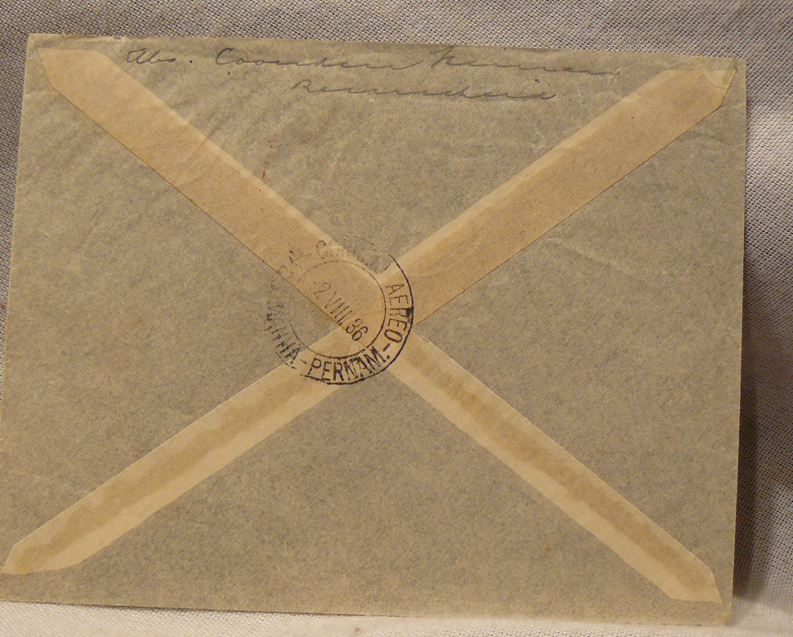A Zeppelin Airship Post Letter, For Flight Returning to Berlin for The 1936 Olympics, on the Brazil to Germany Flight, 27 July 1936
A South American Europe Flight, the Hindenberg’s 31st flight, arrived back from Rio to Frankfurt flight and flew to arrive above Berlin at the Olympic Stadium on the 1st August the Olympics of 1936. Superb condition envelope and franked stamps.
The Hindenburg Zeppelin flew over the Olympic Arena, on the 1st of August, and the envelope was date stamped just a few days before on the 27th, midway on its journey from Brazil back to Germany, returning in order to fly at the Olympic Games opening ceremony.
The Berlin Games are best remembered for Adolf Hitler’s failed attempt to use them to prove his theories of Aryan racial superiority. As it turned out, the most popular hero of the Games was the African-American sprinter and long jumper Jesse Owens, who won four gold medals in the 100m, 200m, 4x100m relay and long jump.
Television Coverage
The 1936 Games were the first to be broadcast on television. Twenty-five television viewing rooms were set up in the Greater Berlin area, allowing the locals to follow the Games free of charge.
Young Olympians
Thirteen-year-old Marjorie Gestring of the U.S. won the gold medal in springboard diving. She remains the youngest female gold medallist in the history of the Summer Olympic Games. Twelve-year-old Inge Sorensen of Denmark earned a bronze medal in the 200m breaststroke, making her the youngest medallist ever in an individual event.
Debuts and Firsts
Basketball, canoeing and field handball all made their first appearances
The Hindenburg made 17 round trips across the Atlantic in 1936, its first and only full year of service, with ten trips to the United States and seven to Brazil. In July 1936 it completed a record Atlantic double crossing in five days, 19 hours and 51 minutes. Among the famous passengers was German heavyweight boxing champion Max Schmeling, who returned home on the Hindenburg to a hero's welcome after knocking out Joe Louis in New York on June 19, 1936. During the 1936 season the airship flew 191,583 miles (308,323 km), carried 2,798 passengers, and transported 160 tons of freight and mail, a level of success that encouraged the Luftschiffbau Zeppelin Company to plan the expansion of its airship fleet and transatlantic service.
The airship was reportedly so stable that a pen or pencil could be stood on a table without falling. Its launches were so smooth that passengers often missed them, believing that the airship was still docked to its mooring mast. The cost of one way passage between Germany and the United States was US$400, an especially considerable sum in the Depression era. Hindenburg passengers were generally affluent, including many public figures, entertainers, noted sportsmen, political figures, and leaders of industry.
The Hindenburg was used again for propaganda purposes when it flew over the Olympic Stadium in Berlin on August 1 during the opening ceremonies of the 1936 Summer Olympic Games. Shortly before the arrival of Adolf Hitler to declare the Games open, the airship crossed low over the packed stadium while trailing the Olympic flag on a long weighted line suspended from its gondola.
During 1936 the Hindenburg had a special Bl?thner aluminium grand piano placed on board in the music salon, although the instrument was removed after the first year to save weight. Over the winter of 1936?37, several alterations were made to the airship's structures. The greater lift capacity allowed ten passenger cabins to be added, nine with two beds and one with four beds, thus increasing the total passenger capacity to 72. In addition, "gutters" were installed to collect rain for use as water ballast: taking on rainwater ballast to compensate for the weight of fuel consumed during a voyage was more economical than venting hydrogen.
Another change was the installation of an experimental aircraft hook-on trapeze based on the system similar to the one used on the U.S. Navy Goodyear-Zeppelin built airships Akron and Macon. This was intended to allow customs officials to be flown out to the Hindenburg to process passengers before landing and to retrieve mail from the ship for early delivery. Experimental hook-ons and takeoffs were attempted on March 11 and April 27, 1937, but were not very successful, owing to turbulence around the area where the hook-up trapeze had been mounted. The loss of the ship ended all prospects of further testing.
Code: 17968
375.00 GBP



